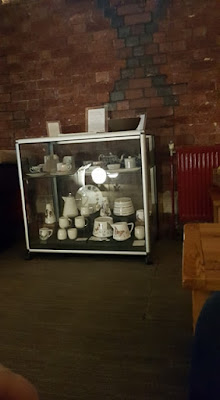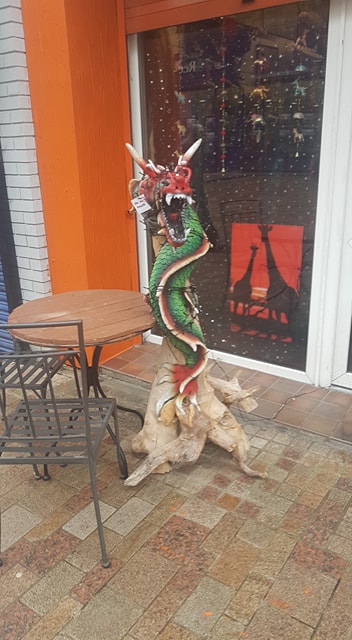Stoke-on-Trent often abbreviated to Stoke) is a city and unitary authority area in Staffordshire, England, with an area of 36 square miles (93 km2). Together with the neighbouring boroughs of Newcastle-under-Lyme and Staffordshire Moorlands, it is part of North Staffordshire, which, in 2011, had a population of 469,000.
Stoke is polycentric, having been formed by the federation of six towns in 1910. It took its name from Stoke-upon-Trent where the main centre of government and the principal railway station in the district were located. Hanley is the primary commercial centre. The other four towns are Burslem, Tunstall, Longton, and Fenton.
Stoke-on-Trent is the home of the pottery industry in England and is commonly known as the Potteries, with the local residents known as Potters. Formerly a primarily industrial conurbation, it is now a centre for service industries and distribution centres.
Hanley no longer has a railway station but there was once one located on Trinity Street, on the Potteries Loop Line, which was opened by the North Staffordshire Railway for passengers on 13 July 1864. The station survived for 100 years – it was closed in 1964, as part of the Beeching Axe, and the land is now a car park.
Hanley is also connected to the waterways network; it meets the Trent and Mersey Canal at Festival Park, it is also connected to the east of the country via the Cauldon Canal.
The Bell Pottery, Bethesda Street, Hanley - 1953
this view is looking along Bethesda Street
(see the arrow and circle on the map below)
the kilns of the Bell Pottery are being demolished to make way for
a new Museum and Art Gallery which opened in 1956
Hanley, in Staffordshire, England, is one of the six major towns that joined together to form the city of Stoke-on-Trent in 1910. Hanley was the only one of the six towns to be a county borough before the merger; its status was transferred to the enlarged borough. Hanley was incorporated as a municipal borough in 1857 and became a county borough with the passage of the Local Government Act 1888.
It is now the city's main shopping centre, the Potteries Shopping Centre containing many high street chain stores.
Debenhams store that is part of the centre, and on the wall is one of the notable artworks in the city.
It is called the “Man of Fire” and is older than it looks. It was first hung up in 1963, towering 35 feet over the entrance to the shop which was then a Lewis’s until Debenhams took over in 1998. It was designed and built by David Wynne from London and when he was making it he decided it should have something to do with the Potteries as Stoke-on-Trent is nicknamed the Potteries so he based the artwork around the fires in the kilns that dominate the city.
Debenhams - Hanley, Stoke-on-trent ST1 1LT
Debenhams plc is a British multinational retailer operating under a department store format in the United Kingdom and Ireland with franchise stores in other countries. The company was founded in the eighteenth century as a single store in London and has now grown to 178 locations across the UK, Ireland and Denmark. It sells a range of clothing, household items and furniture and has been known since 1993 for its 'Designers at Debenhams' brand range.
Headquartered in Regent's Place in the London Borough of Camden, Debenhams is listed on the London Stock Exchange. The company owns the Danish department store chain, Magasin du Nord, and has a subsidiary in Ireland.
Hello..Lee
The Potteries Museum and Art Gallery. Inside it contains a large collection of ceramics from Staffordshire and Stoke-on-Trent as a whole, as well as historical items from the local area. One of the most popular exhibits is a Supermarine Spitfire, designed by R. J. Mitchell (1895 – 1937, from nearby Butt Lane) during World War II.
On the outside, two statues are present down the side of the building, one of Mitchell himself, and one of a man dressed in silver, who I am told was a Steel Worker. The statue was created as part of a public fundraising event to make a tribute to the workers at Shelton Bar, a huge 400 acre site with over 10,000 workers, which opened in 1830 in an area called Shelton, nestled between Hanley and the main area of Stoke. It was also the largest steel rolling mill in the whole of Europe, and as such was a big target for the German Luftwaffe during World War II, who tried a number of times to bomb the factory. Sadly most of the plant closed in 1978 and a lot of workers lost their jobs. They are now remembered thanks to the statue, a stunning tribute to generations of workers.
There are a number of other museums in Stoke to do with it’s ceramics heritage, including the Gladstone Pottery Museum and the Etruria Industrial Museum all located in and around Hanley. Heading towards Burslem you will find the Barewall Gallery, Moorcroft Factory Shop and Visitor Centre.
It was at this point that we set off towards the neighbouring town of Newcastle-under-Lyme, which directly borders Stoke-on-Trent. On the way we passed over a few canals, saw a few more kilns and went over both the West Coast Main Line and the A500 main road. You can find our walk here on Google Maps. We went in a loop, out of Hanley to Newcastle and back round to the Stoke area of the city where the station is located, so I shall pick up this post after we re-entered the city borders at Stoke…
Stoke Ski Center At Hanley
Ski resort in Stoke-on-Trent, England
Address: Festival Park, Stoke-on-Trent ST1 5PU, UK
Hours: Open today · 10AM–9PM
Phone: +44 1782 204159
Jasper Conran
Royal Doulton
Fine Bone China
Royal Doulton
Fine Bone China














































































ReplyDeleteI read your blog about books storage, blog is very much interesting and outstanding, else this storage of other things also exist in place. I know one of the best and good storage that of good quality # Self Storage worcester
lso give cheap services in all over the world ... Many of people and other areas people most prefer to get their services ...